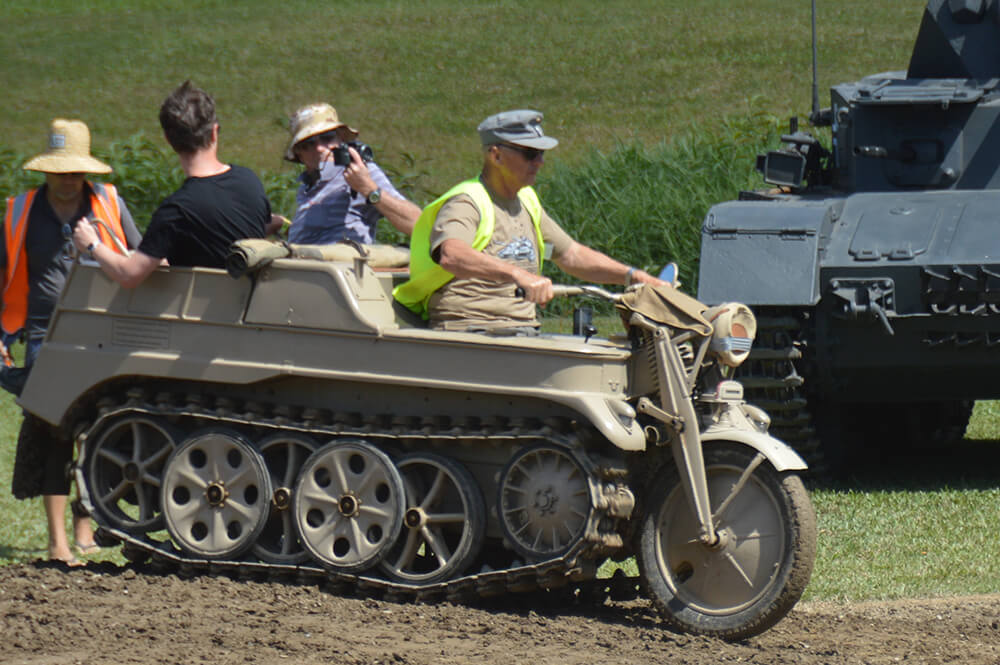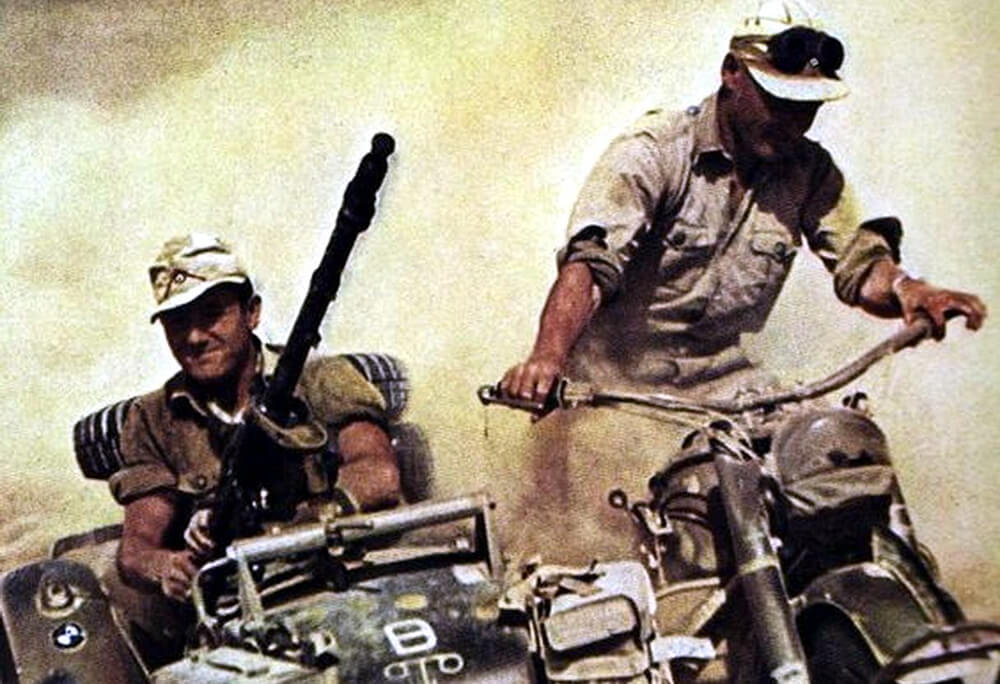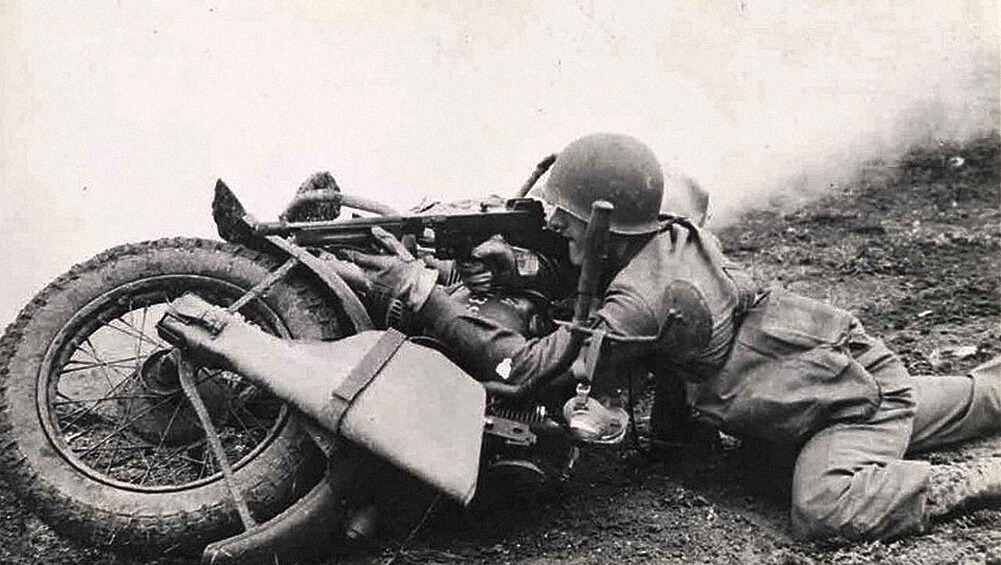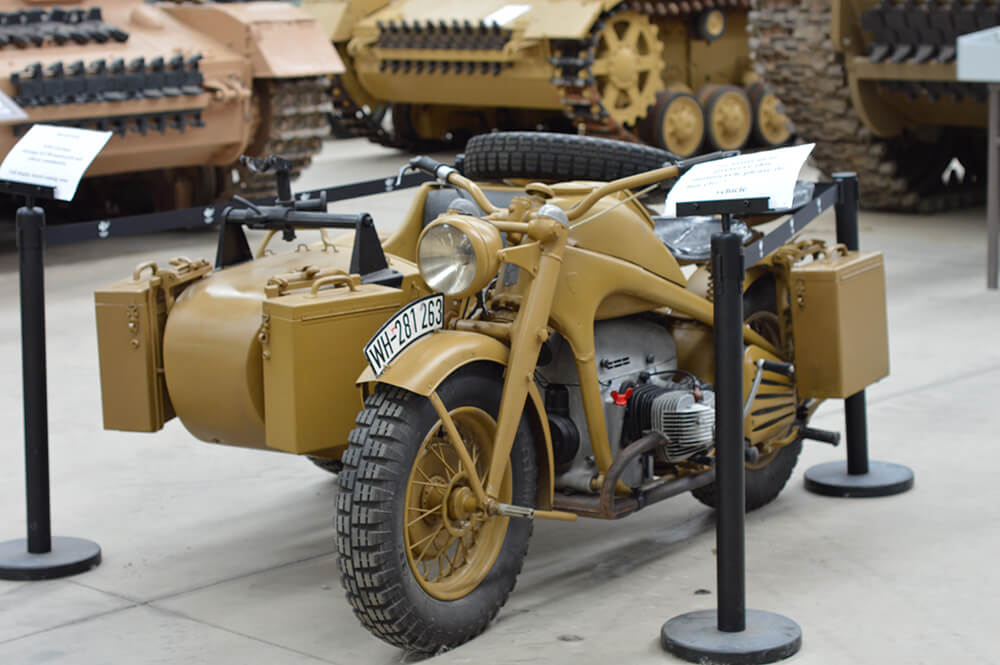First up, this is not a deep dive into every single motorcycle that made its way onto the field of battle.
Why? Because mainly I’m lazy and there are literally volumes upon volumes of literature on the subject that could fill a shipping container.
So, in the interest of managing expectations and a way of masking my complete laziness to avoid falling down a huge, gaping research ‘rabbit hole’.
Let’s look at this yarn as more of a ‘Greatest Hits’ compilation if you like.
You can bet London to a brick that once the first motorcycle rolled off the assembly line, it caught the eye of the military with the view of enhancing troop movement and communications on the battlefield.
Motorcycles Were Mostly Employed For Message Delivery
Looking back at the history of the motorcycle in combat, it’s generally accepted that the Mexican Revolutionary, Poncho Villa aboard his 1914 Indian Power Plus Big twin was the first to employ them in the field to raid and harass.
This tactic was swiftly adopted by General Black Jack Pershing in his pursuit of the rouge Mexican.
Pershing, who with his 5000 men sent by the US President Wilson to go toe to toe with the errant Poncho, did so with a number of gunned up troops astride the 989cc V2 Four stroke ‘J’ Model 17 Harley-Davidsons.
This H-D was no slouch and with a simple three-speed transmission that was mounted to the gas tank, managed a claimed 138klm/h.
In typical Yank fashion they made some modifications adding a sidecar and turned them into highly mobile gun platforms by adding machine guns.
This was the first time the US Military employed motorcycles in an armed conflict, and they were impressed.
So impressed with the H-D performance in the harsh Mexican terrain, they would return with their shopping carts years later to purchase more of them when they joined ‘The Big Dance’ in WW1.
Not to be left out, the Indian Brand now found that it was in danger of some serious competition with its ridiculously popular Power Plus models now seeing Harley in their rear-view mirror (both competing on the track) and when tendering for big Government Military contracts.

Motorcycles Presence Felt In The War
World War I
The Great War was the real changing point for a great many things.
The horse was still being employed, however the times they were a changin’ as conflict became more mechanised.
Lumbering great tanks, aircraft motor vehicles and motorcycles began to make their presence felt in the conflict.
Meanwhile, the poor old pony, despite being loved and admired, was slowly but surely being issued the old ‘don’t come Monday’ notice.
The early use of the motorcycles was predominately used for the dispatching of messages.
Not that those duties were mundane, but now, whole infantry units were eventually saddled up and told to go forth, with stretcher-bearing medico units on standby to motor in and aid the wounded.

Motorcycles In Action!
In 1914, the early models fielded were little more than powered push bikes.
The British Expeditionary Force left for France in August of that year with 247,000 men, 827 cars and only 15 motorcycles.
Things changed dramatically however when a unit of the newly formed Pommy recon bikers rolled up on a German unit at Oberg, kicking off a fire fight between the two.
Things must have gone the recon biker’s way as the incident got the British Brass thinking about the effective use of mobile fire teams and soon raised more units to carry out recon duties.
Better bikes – more blokes were the mantra.
There is a military saying that states ‘if you are out of comms, then the party is out of beer!’
Like every army tactician, the Brits definitely understood that getting important info across the field in a swift and timely manner was vitally important.
With that in mind the new, heavily trialled Triumph H Model powered by a 499cc was soon seen lumping through the battle zones.
The Trumpy proved itself so much so that it scored the title ‘Trusty’.
Meanwhile, Military Police astride their respective country’s service bikes were escorting and directing convoys enroute to the Front lines.
The First World War was the opportunity for newly mechanised countries to develop and hone the use of motorcycles in combat.
Some more so than others.
The ability of moving large numbers of amped-up troops at speed had lots of appeal, particularly if you’d just had your arse kicked in a World War and felt that you wanted to, oh, I don’t know…invade Poland at some point in the future.

Highway Performance
Between the Great War and the brewing next season of ‘World War – Part Two’, manufacturers such as Triumph, Norton, BSA, H-D and Indian (to name a few) were whipping together newer and more reliable models.
Not just for the growing domestic and recreational motorcycle market but also to cater to the growing military applications.
Motorcycles Usage In Various Countries During The War
By 1937, BSA had developed the M20 500cc beast with a sidecar option which managed to impress the UK War office greatly.
They eventually took 126,000 models for service during the Second World War, many of which appeared on duty with our Aussie Diggers in Australia, Africa and The Pacific Theatres of War.
The low-end grunt worked a treat scrambling up hills, sand and chopped up muddy terrain.
For the good guys, WWII saw the Triumph Models return for the Commonwealth while Harley-Davidson scooped the pool with massive WLA Government orders to service the Yank’s needs.
Meanwhile, in the Rhineland, manufacturers BMW and Zündapp were making their presence known as part of an unwanted local touring side.
Rugged, durable and apparently more reliable than their allied opposite number, both the BMW and the Zundapp models saw action everywhere from the snow-covered plains of Russia to the scorching deserts with Rommel’s Africa’s Korp.
Then there was the Kleines Kettenkraftrad Type HK 101.
Fun to say, hard to backflip and at three metres in length, one metre wide and weighing in at an impossible 1560 kgs, it was known to be a little top heavy.

When it was not trying to compact its German rider into his ‘Stahl helm’, it was used for everything from towing artillery, running out communication wire and towards the end of the war, towing aircraft.
Fun fact, it was still being produced after the war for use on farms right up to 1958.
Meanwhile, Japan was also onto the idea of including motorcycles in their shot at taking over the other half of the World.
However, the Imperial Japanese Army really didn’t like taking their Type 97 – WLA ‘knock offs’ into the jungle that much, and for good reason.
At 500kgs and 2.7 metres, this 1274cc rice burner beast was apparently a nightmare when it hit its top speed of around 70 kms/hr. Strapping a sidecar to it did no favours either.
Back in Mother Russia, the Soviets got with the program in the fighting back of their former best mates and now invading hordes – ‘Ze Germans’.
They urgently needed to replace the TIZ AM 600 and PMZ A750 which was such a pig that it was dubbed the PMZ the ‘Poprobol Menya Zavedi’ which translates to ‘try and start me’.
The Soviet built M-72 was introduced to replace these porkers which pretty much failed in the field.
The M72 model was the most widely used in the Red Army in ‘41-‘45, its design taken from the BMW R71 which was equipped with the Wehrmacht.
During the five war years, M-72s were transported by soldiers armed with light mortars and machine guns.
In the post-war period, the M-72 became the main transport of the Soviet militia; civilians were able to purchase this bike only in 1954.

Wheels Of Wars Continued…
In all theatres of the Second World War, the motorcycle made its presence known.
Throughout New Guinea, the Desert and Europe, men put their lives on the line astride two wheels.
Highly targeted by everything from snipers to dive bombers, dispatch riders would weave their way across the lines to deliver critical instructions that affected the ebb and flow of battle.
It’s also suggested that the reason that the colour green on a motorcycle is bad luck goes back to the olive-green paint on the dispatch rider.
Next Month we cast the spotlight on the Korean, Vietnam and more modern conflicts, including a chat with a current member of the Australian SAS Regiment who trained our special forces motorcycle reconnaissance teams.
Check out our LiveToRide magazines for even more fascinating content to keep your riding passion going.

























